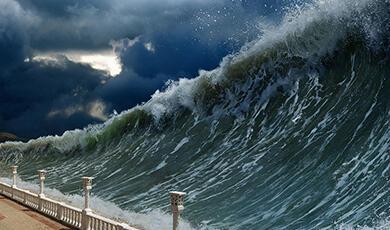Volcanoes and Society
Share
- Details
- Transcript
- Audio
- Downloads
- Extra Reading
There are an estimated 800 million people living close enough to active volcanoes to be affected when they erupt. As well as casualties from volcanic eruptions there can be major economic losses and societal disruption, especially when communities have to be evacuated. The eruption of Eyjafjallajökull volcano in Iceland in April-May 2010 did not kill anyone but disrupted the travel of millions of people and cost the airline industry billions of dollars. This highlighted the increasing vulnerability of modern globalised societies.
New approaches to volcanic hazard assessment and risk management are emerging as more information is required to respond to volcanic emergencies – illustrated by approaches to some recent eruptions, such as the Soufriere Hills Volcano, Montserrat.
Download Transcript
20 February 2019
Volcanoes and Society
Professor Sir Stephen Sparks
There are thought to be about 800 million people living close enough to active volcanoes to be affected when they erupt. As well as casualties from volcanic eruptions there can be major economic losses and societal disruption can be considerable, especially when communities have to be evacuated. The risk is growing because of population growth and the increasing vulnerability of globalised modern society.
There are 1554 active volcanoes in the Smithsonian catalogue. These volcanoes are largely located on the boundaries of the great tectonic plates that characterize the outermost parts of the solid Earth. Of these 551 have a record of an historic eruption. About one volcano with no previous historic record erupts every two years. People living near long dormant volcanoes that reawaken can be particularly vulnerable because they have no previous experience of the hazards that threaten their lives and livelihoods. There are about 50 eruptions per year on Earth, but most do not hit the media headlines because they are small or occur in remote regions. At least 250,000 people have died due to volcanic eruptions, which is small compared to other major natural hazards, such as earthquakes, floods and hurricanes. However, economic and social costs can be very high with major disruption and societal dislocation. Global vulnerability is increasing with urbanization, population growth and increasing dependence of the functioning of modern society on critical infrastructure and transnational economic relationships. Very large eruptions can also adversely affect climate, creating unusual weather around the World in the following few years. In this talk I will give examples of some recent volcanic emergencies to illustrate the wide range of impacts and approaches to managing these emergencies to save lives and reduce risk.
Volcanic eruptions from other natural hazards in two important ways. First there several different volcanic phenomena that are hazardous, which differ greatly in their distribution and impacts. Second, many volcanic eruptions are not rapid onset events and can last much longer than hurricanes or earthquakes. Hazards include: lavas which burn anything their path; explosions which hurl huge rocks distances of up to a few kilometres; deadly pyroclastic flows that are devastating fast-moving flows of hot ash and gas; lahars that are flows of water and volcanic debris; volcanic ash which cause roofs to collapse, can threaten the safety of airplanes and is detrimental to health; and volcanic gas which can lead to death, pollution and damages to critical infrastructure (e.g. power supplies). Many eruptions can last many weeks, months and years, while there are a few volcanoes which erupt almost continuously. Eruptions are always preceded by periods of unusual phenomena, such as small earthquakes and movements of the Earth’s surface. Such episodes can be the signs of an impending eruption but there also many cases where there is no eruption. These attributes lead to significant challenges in managing the risk and tragedies can occur if these challenges are not met.
The above points are illustrated by some famous eruptions. On 8th May 1902 an eruption of the Mont Pelée Volcano, on the island of Martinique in the Caribbean completely destroyed the town of St Pierre and almost all of its 29,000 inhabitants were killed. The pyroclastic flow travelled from the volcano to the town in a few minutes without warning. However, there had been many earthquakes and minor eruptions in the previous several weeks. A decision about evacuation was postponed by public officials because of an impending election. In 1976 the Soufrière Volcano on the neighbouring island of Guadeloupe started show unrest with many earthquakes and small steam explosions. The authorities, no doubt with the tragedy at St Pierre very much in their minds, evacuated over 70,000 people for over 3 months causing great distress and difficulties. However, no eruption took place and there were major public disputes between rival scientists about the wisdom of evacuation. One certain result was the loss of trust of people in politicians and scientists. Another infamous tragedy occurred at Nevados del Ruiz volcano, Colombia in 1985 when 25,000 people lost their lives in the town of Amero when eruptions at the ice-covered summit melted the glacier and a mixture of water and volcanic debris known as a lahar poured down the moment. There was no warning and the tragedy highlighted the need for better communications. The eruption on Guadeloupe and tragedy of Almero led to major improvements in the monitoring of volcanoes worldwide.
A much more successful outcome than the above cases happened in November 2010 when 400,000 people were evacuated from the flanks of Merapi Volcano in Indonesia. Although a few hundred people tragically lost their lives it is estimated that at least 15,000 lives were saved. An altogether different situation developed in communities around the Galeras volcano, Colombia in the 2000’s. The volcano is persistently active and so several villages of indigenous people are located under the shadow of the volcano. The Colombian Government sought to relocate the villages, but the villagers refused to leave having lived with the volcano for many centuries without mishap. Most recently eruptions of Krakatoa volcano in Indonesia eventually led to a large section of the island volcano sliding into the sea, resulting in a devastating tsunami that destroyed many coastal communities in Java and Sumatra with terrible loss of life.
Two recent volcanic eruptions greatly affected the United Kingdom, namely the eruption of the Soufrière Hills Volcano Montserrat (1995 and 2010) and the eruptions of two Icelandic volcanoes in 2010 and 2011. These emergencies are discussed in more detail to consider the impacts of volcanism on society, to illustrate issues around emergency management and to describe new approaches to volcanic hazard assessment and risk management.
The eruption of the Soufrière Hills Volcano, Montserrat which began in July 1995 came as a complete surprise to the island of about 12,000 inhabitants. The volcano had never erupted since it was colonised in 1632. The United Kingdom were responsible as Montserrat is an Overseas Dependent Territory. The eruption escalated during 1996 and 1997. 20 people lost their lives on 25 June 1997. By the end of 1997 two-thirds of the population had been evacuated from the island and the viability of the island was in question. With the establishment of a new Montserrat Volcano Observatory (MVO) and an improving understanding of the volcano Montserrat survived and the situation stabilised even though the eruption continued until March 2010. In 2003 the economic losses associated with the eruption were estimated to have exceeded 1 billion $US.
The eruption of the Soufrière Hills Volcano provided an opportunity to develop innovations in how long-lived volcanic emergencies are managed and how risk is assessed. The MVO was operated mainly Caribbean and UK scientists. The Governments of the UK and Montserrat also convened a Scientific Advisory Committee (SAC) to assess the hazards and risks at the volcano working closely with the MVO. A methodology was pioneered to use expert elicitation to assess risk quantitatively and use the resulting assessments to inform decisions on management of the emergency including evacuations. The committee and MVO staff made assessments of the activity of the volcano and projected forward on the likelihood of various outcomes. Mostly these were long term forecasts for periods of 6 months but some informed decisions to evacuate or not to evacuate in much shorter time frames. An innovation was to calibrate the experts on the team for their knowledge of the underlying science, ability to integrate many different strands of scientific evidence and skills in evaluating uncertainties. By comparing results of volcanic risk assessment with regional earthquake and hurricane risk decisions were made that enabled the island to be sustained safely.
In 2010 the UK woke up to the global reach of volcanism. A he modest sized eruption of Eyjafallajokull volcano in Iceland in April and May 2010 did not kill anyone but disrupted the travel of millions of people and costs the airline industry billions of dollars. This emergency highlighted the increasing vulnerability of modern globalised societies. are emerging as Society requires more information to respond to volcanic emergencies. For traffic across Europe was halted for several days as engine manufacturers, airlines and governments struggled to decide whether it was safe to fly. In 1981 a British Airways flight over Indonesia almost crashed when all four engines ceased functioning as the plane encountered a volcanic ash cloud. Fortunately one engine restarted so disaster was averted. To respond to global threat to aviation, a network of global ash monitoring and forecasting Centres was set up with close links to meteorological agencies and air traffic control. A protocol was developed where pilots were diverted around the ash clouds to avoid the hazard. However, in 2010 Europe had the World’s busiest commercial flight zones and the policy proved impractical. The UK was at the centre of the crisis and needed experts in meteorology, volcanology and aeronautical engineering and air traffic control to find solutions rapidly. By allowing aircraft to fly through regions of the atmosphere with low concentrations of ash, flights were re-opening but continued to be disrupted for weeks. A heady mix of panic, politics, science, engineering and realism tensioned passenger safety against commercial pressures. When the Grimsvotn volcano, Iceland, erupted in 2011 the UK was much better prepared. Up to that point volcanic eruptions were not on the UKs national risk register but they are now.
Volcanic eruptions occur in a particular country and the major effects are usually local and confined within the borders. Thus the responsibility to deal with volcanic risk is usually through national science and civil protection agencies. However, the threat to aviation has been addressed though globally co-ordinated centres. The greatest challenges from volcanic risk are though in the future. Very large eruptions can have regional (as in the case of recent Icelandic eruptions) and even global impacts. The modern globalised World has not yet experienced a really large explosive eruption that can perturb global climate.
© Professor Sir Stephen Sparks FRS CBE Kt, 2019
University of Bristol
Part of:
This event was on Wed, 20 Feb 2019
Support Gresham
Gresham College has offered an outstanding education to the public free of charge for over 400 years. Today, Gresham plays an important role in fostering a love of learning and a greater understanding of ourselves and the world around us. Your donation will help to widen our reach and to broaden our audience, allowing more people to benefit from a high-quality education from some of the brightest minds.


 Login
Login







